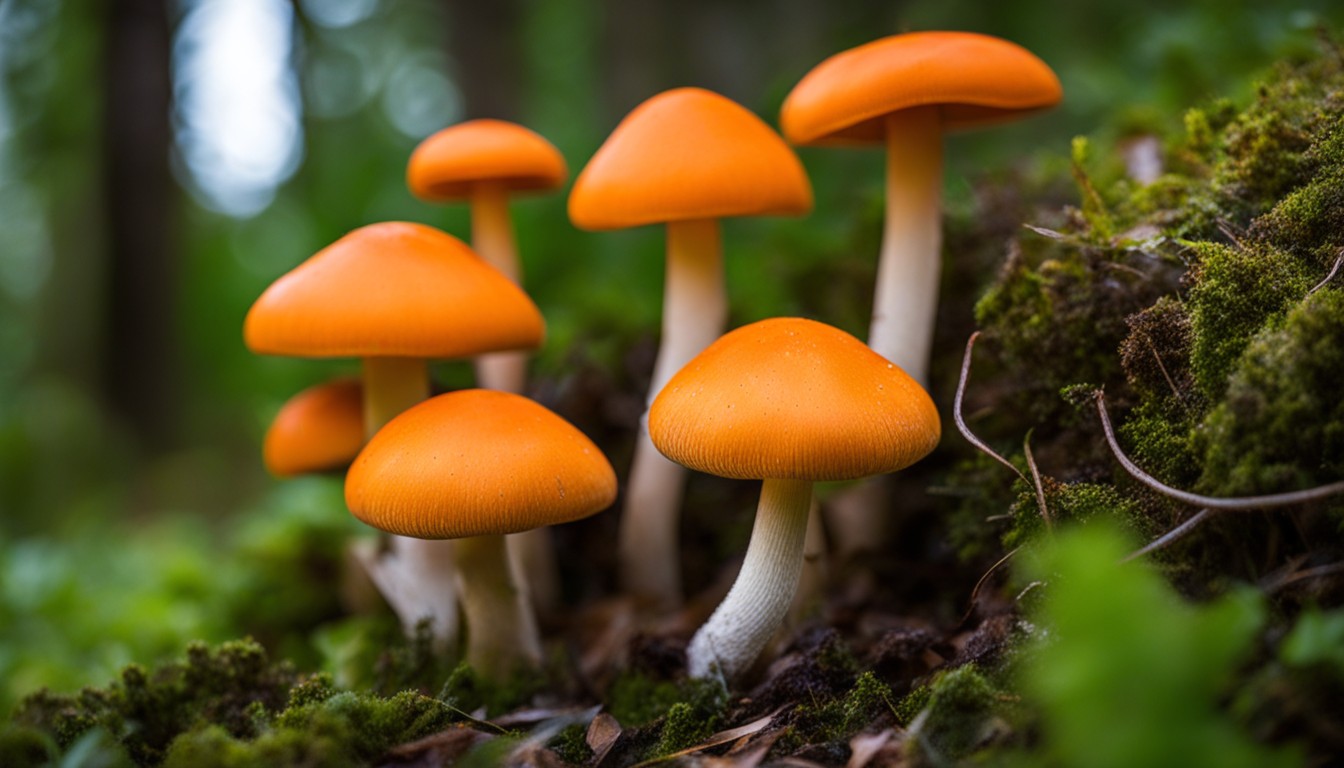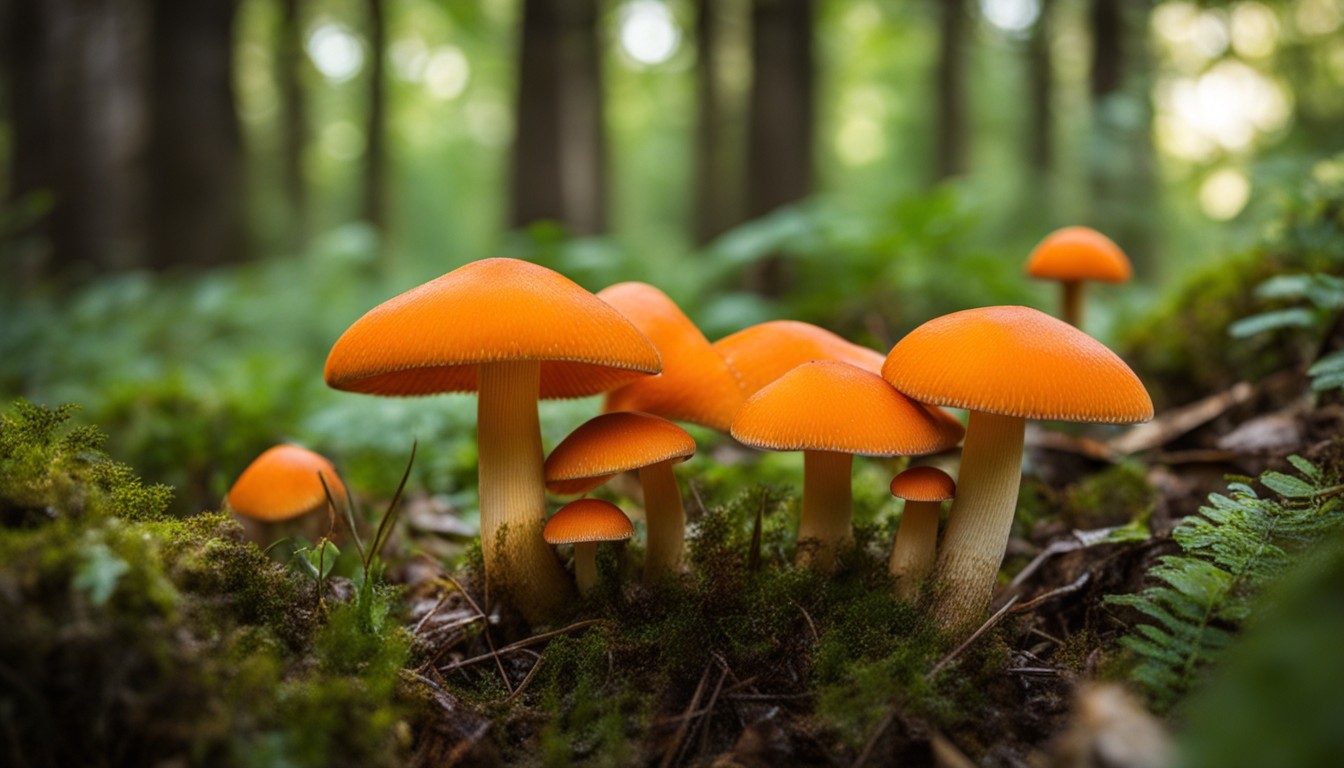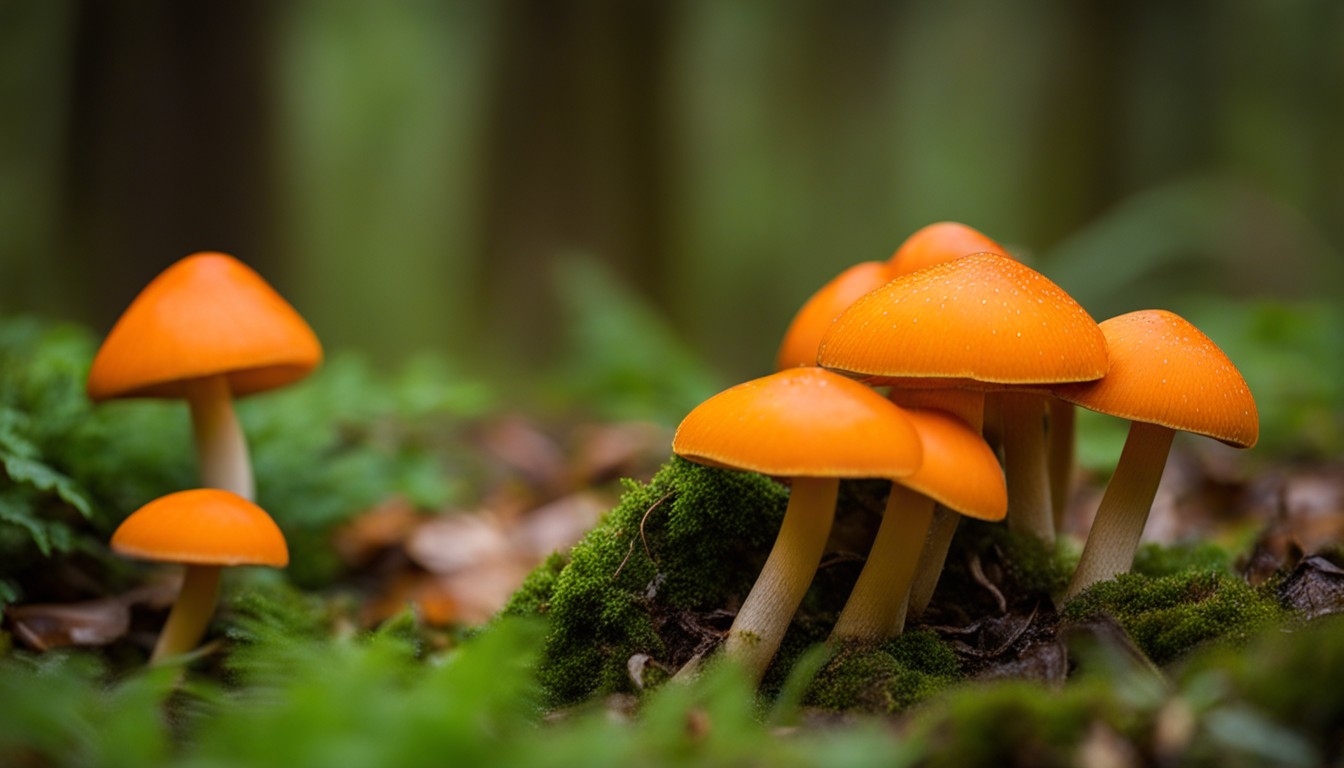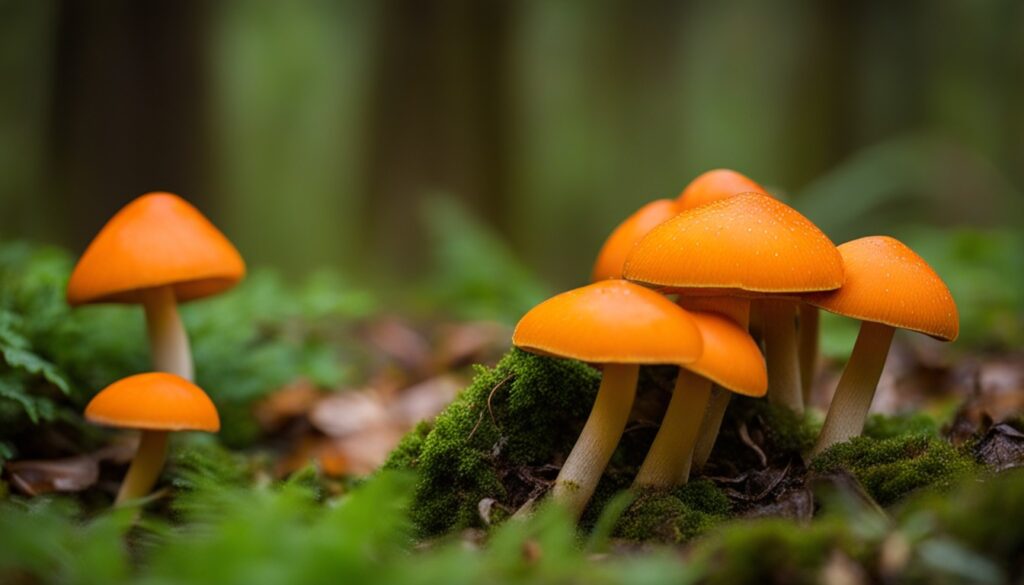Orange mushrooms in yard Florida can be a common sight, but it’s important to be able to identify them correctly. In this comprehensive guide, we will help you understand the various types of orange mushrooms that can be found in Florida yards and provide tips on how to manage them effectively. From discussing the characteristics and habitats of different species to sharing expert advice on control methods, this article aims to equip homeowners with the knowledge they need to identify and address orange mushroom growth in their yards. Whether you’re a gardening enthusiast or simply want to ensure a safe and visually appealing outdoor space, this guide will serve as a valuable resource.
Identifying Orange Mushrooms
A firm grasp on the anatomy of orange mushrooms is crucial in their identification. Pay attention to their cap size, stem thickness, and spore print color. These attributes differ from species to species.
The identification of orange mushrooms relies heavily on anatomy, habitat, and seasonality, shifting with different species and environments.
Factors such as habitat and seasonality also play a crucial role in correctly identifying orange mushrooms. Regularly observe your yard during varying weather conditions and seasons as certain types of these fungi may primarily emerge during specific periods.
Characteristics of Orange Mushrooms
While significantly varied, orange mushrooms often display striking features. Their cap shapes and sizes, color tones, and complicated gill structures contribute to their distinct identities, easily setting them apart from other fungi.
- In terms of cap shapes, orange mushrooms can have flat, conical, or umbrella forms.
- Sizes of orange mushrooms usually range from small to medium, though some species may grow considerably larger.
- Different hues of orange can be observed, from bright orange to burnt orange, and even orange with shades of red or brown.
- The gill structures can be either free or attached, depending on the specific species of orange mushroom.
Common Types of Orange Mushrooms in Florida
In the diverse biome of Florida, the mushroom variety is abundant. Two common types of orange mushrooms one can encounter are various species of Amanita and Chanterelles.
- Amanita species: Recognizable by their bright orange or yellowish caps and white gills, they grow chiefly in woodlands.
- Chanterelles: They boast a distinct golden hue and have a fruity smell, often found in damp, mossy forest areas.
Similar Mushrooms to Watch Out For
Orange mushrooms have a deceptive group of look-alikes that may seem harmless but can pose a serious hazard if misidentified. It’s crucial to recognize the subtle differences between edible and toxic species.
- Beware of the deadly Omphalotus olivascens, often mistaken for the edible Jack-o-Lantern. Smaller and darker, this toxic look-alike emits light in dark areas.
- The toxic Amanita muscaria, though not an exact orange, it’s often mistaken due to its orange-red cap.
- Rhodotus palmatus, toxic and a look-alike, note the wrinkled cap and white stem.
- The deadly Galerina marginata, deceptively harmless in appearance, distinguished by its orange-brown cap and stem.
How to Spot Orange Mushrooms in Your Yard
Sharp vigilance is your first line of defense against orange mushrooms infestation. Understanding the signs of fungal activity and the right time to conduct checks can greatly aid in effective mushroom management.
- Watch for patches of discolored or damp grass, which can indicate fungal growth underneath the surface.
- Look for rings or clusters of small, rounded structures that could potentially be immature mushrooms.
- Early morning or late evening inspections are best as mushrooms typically sprout overnight.
- Inspect your yard after heavy rainfall, as damp conditions are ideal for mushroom growth.
Impact of Orange Mushrooms

Orange mushrooms, while ostensibly harmless, can have considerable ecological effects on Florida’s ecosystems, shifting delicate balances and affecting the health of various plant species, often introducing new competition for existing Florida fungi.
The diversity of orange mushroom species can influence the surrounding flora and fauna in assorted ways, from decomposing organic material to facilitating nutrient cycles, each species leaves a distinctive imprint on its environment, playing an important role in biodiversity.
Are Orange Mushrooms Dangerous?
Orange mushrooms exhibit a spectrum of toxicity levels. While some are perfectly safe to touch and even eat, others can have serious effects on both humans and pets. With symptoms ranging from nausea to potential liver damage, accurate identification is critical.
At first glance, harmful and safe orange mushrooms can appear strikingly similar. To distinguish between the toxic variety and its benign counterparts, look for characteristics such as a ring around the stem or a bulbous ‘cup’ at the base – these often hint at toxic species.
While some orange mushrooms are used in gourmet cooking, the risk lies in misidentification. Without the right expertise, it’s dangerously easy to mistake a toxic orange mushroom for a harmless, or even edible, species. When in doubt, erring on the side of caution is always best.
Effects of Orange Mushrooms on Plants and Soil
Orange mushrooms, surprisingly, play an integral role in soil fertility and health. As primary decomposers, they help in breaking down organic material, improving soil structure and nutrient availability for plants. In addition, these fungi create symbiotic associations with plant roots, often contributing to enhanced plant growth and productivity.
- Role of orange mushrooms in breaking down organic material
- Contribution to soil structure and nutrient availability
- Symbiotic relationships with plant roots leading to improved plant growth
Signs of an Orange Mushroom Infestation
Early signs of orange mushroom infestation are easily noticeable. You may see small, colorful, or fleshy protrusions emerging from the ground. These mushrooms often have slender stalks and distinctive orange caps.
As the infestation escalates, groupings of these fungi will increase in number, forming obvious clusters. This growth can spread quickly across the lawns and under the shade of trees, especially during rainy seasons.
Infestations can become worrisome if mushrooms start outnumbering your plants. They can colonize larger areas, threaten the balance of your garden ecosystem, and may create an unsightly appearance. They can also be a concern if children or pets are around, as some types can be toxic.
More profound signs include a change in the color of your lawn or plants due to the fungi’s decomposition activity and the appearance of an unusually moist area provoked by the water-retaining ability of mushrooms.
Managing Orange Mushrooms
Management of orange mushrooms utilizes various techniques, such as removing decaying organic matter in the yard and limiting overwatering. Fungicides serve as effective tools against mushrooms, yet they should be used judiciously to prevent harm to beneficial fauna and flora.
A responsive plan to control orange mushrooms involves proactive prevention coupled with timely intervention. Yard hygiene, selective watering, and vigilant monitoring enhance prevention, while the prompt removal of spotted mushrooms aids in the containment of their spread. This ensures your yard remains well-protected and vibrant.
Safe Removal Techniques
Employing gloves and a small trowel, gently uproot orange mushrooms, ensuring not to disperse spores inadvertently. Remember to dispose of these fungi in sealed bags, minimizing their prevalence in your yard.
Non-chemical removal methods are also viable. One beneficial technique is to alter the environment’s humidity, as fungi thrive in moist areas. By regulating watering and improving drainage, mushroom growth can be curtailed.
Preventing Orange Mushrooms
Implementing effective landscaping techniques like aerating your lawn regularly and ensuring proper sunlight exposure can mitigate orange mushroom growth. Balancing the moisture level, as well as frequent raking of leaves and grass clippings, can significantly minimize the development of these organisms.
Biocontrols offer an eco-friendly way to manage orange mushrooms. Introducing natural predators like certain insect species into your yard can disrupt the life cycle of these fungi, thereby helping control their spread and maintaining a healthy landscape.
How to Remove Orange Mushrooms from Your Yard
In order to manage orange mushrooms effectively and sustainably, environmental-friendly practices should be front of mind. A combination of biological controls like the introduction of competing organisms, and careful utilization of water, can significantly influence mushroom prevalence.
Surface sanitation plays a fundamental role in controlling these fungi. By cleaning your yard regularly and removing organic debris that serves as their food source, you stand a significantly better chance at containing mushroom growth and maintaining a healthy yard.
Disposing of Orange Mushrooms Safely

To safely dispose of orange mushrooms, begin by wearing gloves. Ensure you have a trash bag at hand, then gently uproot the mushrooms. Try not to break them as this may release spores into the air. Once gathered, tightly seal the trash bag and dispose it in a designated organic waste zone.
Handling orange mushrooms should be considered with utmost care due to the possibility of harmful effects. Some species may release spores that are harmful to inhale or touch, making proper safety precautions vital, including wearing gloves and a mask while handling them.
One key aspect to note is that simply tossing orange mushrooms into your regular waste bin may not be wise. These mushrooms could spread their spores, potentially growing where they’re not wanted. Ensuring you dispose of them in a bag sealed tightly can help prevent this.
When removing orange mushrooms, do not forget about personal safety. It’s crucial not to touch them with bare hands due to potential toxic effects. Always wear gloves, and when completed, discard the gloves used for mushroom handling to minimize risk.
Engaging Professional Help
Intervention from professionals is necessary when ordinary removal efforts fail or there’s a large-scale infestation. High toxicity species or mushrooms growing excessively near children’s play zones also warrant a professional call.
Selecting a mushroom removal service involves several factors. Check for licensed, experienced experts in your area. Consider the company’s use of chemical or organic treatments, their disposal methods, and the costs for their services.
When to Call a Mushroom Removal Service
Professional mushroom removal becomes essential when the scale of the infestation is beyond home remedies or poses potential threats to children, pets, or plants. These experts are equipped to deal safely and effectively with the widespread and dangerous fungus. Severe mushroom overgrowth is not a situation to take lightly.
Observing a rapid rise in the number of orange mushrooms, significant effect on plant health, or a consistent return even after several removal attempts, are clear indicators of severe infestations. In these situations, immediate intervention from a mushroom removal service is highly recommended.
If non-expert attempts to manage mushrooms cause adverse reactions like skin irritation or breathing difficulties, don’t risk further exposure. In this case, engaging a professional service for removal is not only about controlling the infestation but also ensuring your personal health and safety.
Questions to Ask a Mushroom Removal Expert
Consider inquiring about the company’s experience in handling orange mushroom removal before moving forward. Knowing their level of expertise in the field offers reassurance in their capacity to effectively manage your mushroom problem.
One essential query you ought to pose is whether they have any specific training in identifying and handling specific types of mushrooms, like those in the Florida region. This can support ensuring the job is done safely and correctly.
Ask about the methods they would employ to remove the mushrooms from your yard. It’s crucial to comprehend whether their techniques align with your yard’s condition to avoid additional harm.
Finally, delve into their after-care plans. Do they offer advice on prevention or regular check-ups? Understanding their long-term solutions can illustrate a holistic approach towards effective mushroom management.
Choosing the Right Mushroom Removal Company
When selecting a mushroom removal company in Florida, a close examination of a company’s credentials and experience is crucial. Confirm if they are licensed, and seek reviews or testimonies for higher assurance.
Consider their years of practice, range of services, and customer success stories. Longevity in the business often translates to a wealth of experience in dealing with different mushroom types and conditions.
As a prospective client, don’t hesitate to compare different companies. Use a checklist comprising elements such as competitive rates, reputation, responsiveness, and methods used for identification and removal.
Your final choice should be a company that demonstrates a serious commitment to safety and environmental friendliness, in addition to providing a comprehensive service from inspection through to post-removal care.
Other Considerations for Mushroom Management

In crafting a comprehensive mushroom management strategy for your Florida yard, one needs to consider more than just removal services. Inspection frequency, for instance, plays a vital role in early detection of infestations and preemptive management of mushroom growth.
Besides these, cultural practices such as proper watering and fertilization could substantially decrease the likelihood of mushroom proliferation, especially in Florida’s humid climate. Equally important are proper drainage solutions that prevent any water accumulation, creating unfavorable conditions for mushroom growth.
Another consideration to take into account is mulching choice. Certain types of organic mulches may attract mushrooms, hence, considering inorganic mulching or less appealing organic substrates could reduce mushroom occurrences.
Lastly, revisiting mushroom management strategies yearly allows for adjustments based on any changes observed. With Florida’s variable weather conditions, customized strategies that adapt to changing circumstances can prove significantly beneficial in maintaining a mushroom-free yard.
Frequently Asked Questions (FAQ)
What are orange mushrooms and why do they grow in Florida yards?
Orange mushrooms are fungi that commonly grow in Florida yards due to the warm and humid climate. These mushrooms typically thrive in organic-rich soil, feeding off decaying matter such as dead tree roots or decaying vegetation.
Are orange mushrooms in my yard dangerous?
While most orange mushrooms found in Florida yards are not toxic, it is important to remember that not all mushrooms are safe for consumption. It is best to avoid eating any wild mushrooms unless you are absolutely certain of their identity, as some species can cause adverse reactions or even be fatal if ingested.
How can I identify orange mushrooms in my yard?
Orange mushrooms in Florida yards can vary in size, shape, and texture. They often have vibrant orange caps, sometimes with a convex or wavy appearance. The gills underneath the cap may be white or orange, and the stem can range in color from pale orange to a darker shade.
What should I do if I find orange mushrooms in my yard?
If you discover orange mushrooms in your yard, it is generally recommended to remove them promptly. While they may not be harmful to your plants or lawn, their presence could indicate an underlying issue with decaying organic matter or excessive moisture. To manage their growth effectively, consider improving drainage, removing decaying debris, and ensuring proper lawn care practices.
Can I eat orange mushrooms growing in my yard?
It is strongly advised not to consume any mushrooms growing in your yard unless you have expert knowledge in mycology and can positively identify them as safe to eat. Eating unidentified mushrooms can be extremely hazardous and potentially life-threatening.
Should I be concerned about orange mushrooms spreading?
Orange mushrooms tend to spread through spores, which are released from the gills underneath the cap. However, their spread is usually limited to the immediate vicinity. Implementing proper yard maintenance practices, such as removing decaying material and improving air circulation, can help minimize their spread.
Is it possible to prevent orange mushrooms from growing in my yard?
While it is difficult to completely prevent the growth of orange mushrooms, you can take steps to minimize their occurrence. Maintaining a well-drained yard, regularly removing decaying organic matter, and promoting healthy lawn practices, such as proper watering and fertilization, can help create an environment less conducive to mushroom growth.
Can I use chemicals to control orange mushrooms in my yard?
Using chemicals to control orange mushrooms is not recommended. Given the potential harm to other beneficial organisms and the environment, it is best to focus on addressing the underlying conditions that promote mushroom growth, such as organic debris and excessive moisture.
Remember, if you have any concerns or are unsure about dealing with orange mushrooms in your yard, it is always wise to consult with a local horticulturist or a professional in the field for expert advice tailored to your specific situation.
Conclusion
Navigating successful management of Florida’s orange mushrooms involves understanding their traits, identifying their types, and taking precautions. We need to be aware of their potential impact on our gardens, learn safe removal practices, and recognize when to call professionals.
- Learn traits of orange mushrooms
- Identify their types
- Understand their impact
- Perform safe removal
- Recognize when to engage professionals

